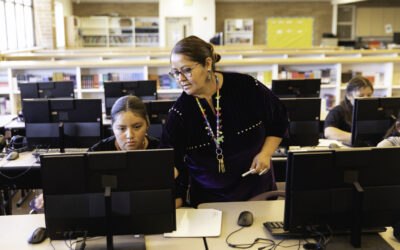Healthy technology boundaries are essential to maintaining a balanced relationship with digital devices and the internet. These boundaries help prevent technology overuse, which can lead to issues like sleep disturbances, increased stress and reduced physical activity.
Boundaries with technology refer to the rules and limits individuals set to manage their use of digital devices and online activities. These boundaries are designed to prevent excessive or unhealthy use of technology, which can lead to negative outcomes such as digital eye strain, sleep disruption, and mental health issues like anxiety and stress. Establishing clear guidelines on when, where and how technology is used helps individuals maintain control over their digital habits rather than allowing technology to dictate their behaviors and routines.
What do Healthy Technology Boundaries Look Like?
By setting boundaries, individuals can develop a more positive relationship with technology. These boundaries help create a balance between online and offline life, ensuring that technology use enriches rather than detracts from personal well-being and real-world interactions. For example, limiting screen time during meals and before bedtime can improve communication within families and promote better sleep. For children, technology boundaries that prioritize educational content and limit recreational screen time can aid in cognitive development and reduce the risk of tech addiction.
Overall, well-defined technology boundaries enable healthier engagement with digital devices, fostering a relationship with technology that supports rather than undermines overall health and happiness.
Below are some examples of healthy technology boundaries for adults and children.
Healthy Technology Boundaries for Children and Teens
- Age-Appropriate Guidelines: Establish rules appropriate for the child’s age and maturity. This includes what kind of content they can view, how much screen time is allowed, and what times of day they can use devices.
- Educational vs. Recreational Screen Time: Differentiate between screen time for homework and educational purposes versus entertainment and encourage more time to be spent on educational activities.
- Parental Controls and Monitoring: Use parental controls to help manage what content your child can access. Regularly discuss internet safety and the importance of privacy.
- Modeling Behavior: Children often emulate adult behavior. Show them how you manage your own screen time and maintain a healthy balance with technology.
- Co-Viewing and Engagement: Spend time together viewing or playing on devices. This not only allows for bonding but also for discussions about what is being consumed.
- Open Communication: Create an environment where children feel comfortable discussing their online experiences and the content they encounter. This openness can help parents intervene when necessary and support their children in handling online challenges such as cyberbullying.
- Encourage Positive Interactions: Educate children on the importance of kindness and the impact of their words online. Encourage them to engage positively and respectfully, reflecting the values they are taught at home.
- Mental Health Awareness: Regularly discuss the impact of social media on emotions and self-esteem. Teach children to be critical of the unrealistic standards often portrayed online and to value their own self-worth beyond social media validation.
Healthy Technology Boundaries for Adults
- Scheduled Disconnect Times: Designate times during the day when you will be free from all digital devices. This could be during meals, the first hour after waking up or the hour before bed.
- Device-Free Zones: Establish specific areas in the home where technology is not allowed, such as bedrooms or the dining room. This encourages sleep hygiene and family interactions.
- Work-Life Balance: Set clear boundaries between work and personal life, especially if you work from home. This includes setting specific work hours and using separate devices or accounts for work-related activities.
- Notification Management: Turn off non-essential notifications to reduce distractions and manage your time on devices more effectively.
- Social Media Limits: Set limits on how much time you spend on social media platforms. Many devices have built-in tools to track and limit usage.
General Practices for Everyone
- Regular Reviews: Periodically review and adjust boundaries as necessary, especially as children grow or new technologies are introduced.
- Digital Detox: Regularly plan days where the family can go without digital devices, focusing on outdoor activities or board games.
- Educational Emphasis: Prioritize and promote the use of technology for learning new skills, such as coding, digital art or online education courses.
- Balance with Physical Activities: Ensure that digital device use is balanced with physical activities. Encourage sports, walking or just playing outside.
Implementing these boundaries not only helps in managing screen time but also in enhancing the overall well-being of individuals and strengthening family relationships.
For more information on maintaining healthy relationships with technology, click “Learn More” below.

Learning.com Team
Staff Writers
Founded in 1999, Learning.com provides educators with solutions to prepare their students with critical digital skills. Our web-based curriculum for grades K-12 engages students as they learn keyboarding, online safety, applied productivity tools, computational thinking, coding and more.
Further Reading
How Were the TEKS Created & What is Its Significance?
The Texas Essential Knowledge and Skills (TEKS) framework details the educational standards in the state of Texas, providing a comprehensive outline...
CIPA Compliance Made Easy with Learning.com
The Children’s Internet Protection Act (CIPA), enacted by Congress in 2000, addresses concerns about children’s access to harmful online content. It...
Students as Logical Thinkers: How Computer Science Teaches Real-World Skills
There is little debate that computer science education has become an imperative curriculum for future-ready students. From modern professions and...




